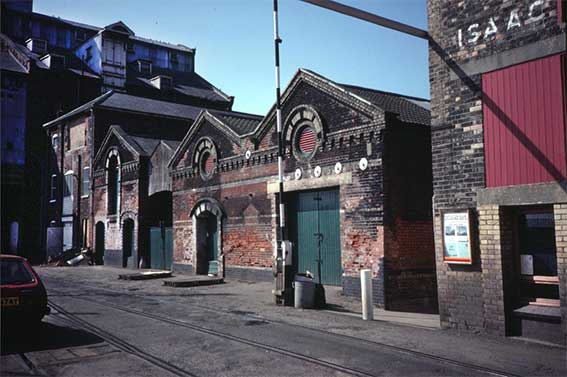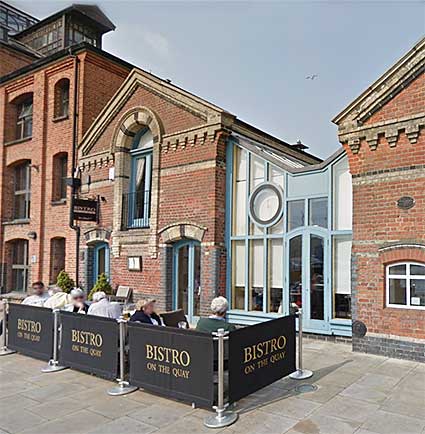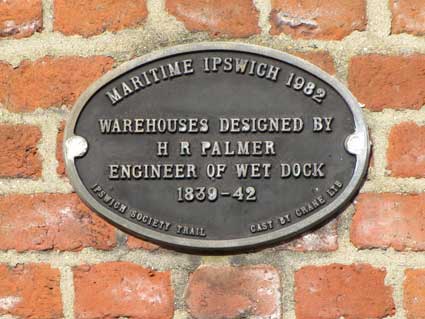WAREHOUSE DESIGNED BY
H.R. PALMER
ENGINEER OF THE WET DOCK
1839-42
IPSWICH SOCIETY TRAIL ... CAST BY CRANE LTD'
[UPDATE
20.7.2016: However, Bob
Malster, historian of all things maritime (see various titles in the Reading list) tells us that this plaque might be
misleading. He has seen the architect's plans for the building and they
were dated 1886. Given that the Wet Dock was opened in January 1842,
this building might have been much later.]
 1980s image courtesy The Ipswich Society
1980s image courtesy The Ipswich Society
Above: This 1980s photograph of the site – Wherry Lane is the gap by the bollard – shows the post-industrial state of the buildings. There is damaged, scraped brickwork which presumably resulted from loading and unloading of carts. Metal discs have been recently inserted above the double doors to add stability to the structure. In the left background is the Paul's Home Warehouse and to the right of the lane is part of the Isaac Lord complex (today's Isaac's bars and restaurants) which bears some the 'Isaac' lettering, as shown on our Isaac Lord page – and today, a ghost sign. Two other oddities: an upright barrier painted in black-and-white can be lowered across the dock tramway, perhaps to hold back traffic while trucks are being turned to enter Ransome's Orwell Works; and a pipe runs out to the dockside horizontally form the Isaac Lord building – perhaps it once loaded grain onto a ship?
The story of Christie's warehouse
These buildings have been converted into offices. But 180 years ago, it was a coal warehouse for the company owned and run by John Christie (b.1798). John and his family would become leading coal merchants in the town during the 19th century. By 1839 Christie was bringing between 500 and 700 tons of coal a month from the coalfields of the north-east of England. These were brought into Ipswich and into the warehouse on Wherry Quay on five of his registered ships, including the Providence and Lady Middleton.
John’s son, Frank A. Christie, was born in 1835 and started out as a draper’s assistant and then a clerk in Ipswich. When John died in 1866, Frank took over and the business expanded. Frank provided work for his two elder sons, Frank Herbert Christie and Leonard Alexander Christie; they were both clerks with Frank H. Christie also being the company accountant.
In 1894, Frank A. Christie had several premises on Salthouse Street, which included a Coal Warehouse, a Salt Warehouse, Office and Timber Depot as well as Sawmills. Over the following ten years the business developed becoming F.A Christie & Son, Coal, Salt and Timber Merchants. The company office was based on Cliff Road with warehouses still operating on Salthouse Street and Wherry Quay.
Unfortunately, Frank H. Christie died in 1896 aged only 29. In 1907 Frank A. Christie died to leaving the business to Leonard. In 1918 Leonard died and subsequent pressures on the business, both locally and nationally, forced the closure of the company. The decontrolment of coal as well as coal strikes/shortages during and following the First World War hastened the decline of Christie’s. Which was already under pressure from competitors. Following Leonard’s death, the company assets were sold off and acquired by local competitors.
A variety of Christie’s local competitors operated close by during the early 20th century. These included Mellonie & Goulder Ltd which bought the coal aspects of Christie’s in 1924 and William Brown & Son Ltd who acquired the timber interests. Isaac Lord’s was also a close competitor, housed in the building complex right next door to Christie’s warehouses (across Wherry Lane). Today the Isaac Lord complex houses the bar and restaurant Isaac’s on the Quay.
Today all of these once busy industrial buildings sit quiet and unassuming on the modern waterfront, each with many stories to tell. [Information from the Ipswich Maritime Trust website]
The Salt Office was an important component of the salt trade in Ipswich; it is shown on a pre-1830 map on our Isaac Lord page. We think that it was situated between Salthouse Street and Wherry Quay directly on the site of the 1839-42 building which is today's Bistro on the Quay restaurant. In the photograph below, the glazed blue section to the right replaces the yard gates (shown in the 1980s photograph) is a part of the bistro which was built over the yard.
 2019
image
2019
image
Henry Palmer
 1980s image courtesy The Ipswich Society
1980s image courtesy The Ipswich SocietyAbove: This 1980s photograph of the site – Wherry Lane is the gap by the bollard – shows the post-industrial state of the buildings. There is damaged, scraped brickwork which presumably resulted from loading and unloading of carts. Metal discs have been recently inserted above the double doors to add stability to the structure. In the left background is the Paul's Home Warehouse and to the right of the lane is part of the Isaac Lord complex (today's Isaac's bars and restaurants) which bears some the 'Isaac' lettering, as shown on our Isaac Lord page – and today, a ghost sign. Two other oddities: an upright barrier painted in black-and-white can be lowered across the dock tramway, perhaps to hold back traffic while trucks are being turned to enter Ransome's Orwell Works; and a pipe runs out to the dockside horizontally form the Isaac Lord building – perhaps it once loaded grain onto a ship?
The story of Christie's warehouse
These buildings have been converted into offices. But 180 years ago, it was a coal warehouse for the company owned and run by John Christie (b.1798). John and his family would become leading coal merchants in the town during the 19th century. By 1839 Christie was bringing between 500 and 700 tons of coal a month from the coalfields of the north-east of England. These were brought into Ipswich and into the warehouse on Wherry Quay on five of his registered ships, including the Providence and Lady Middleton.
John’s son, Frank A. Christie, was born in 1835 and started out as a draper’s assistant and then a clerk in Ipswich. When John died in 1866, Frank took over and the business expanded. Frank provided work for his two elder sons, Frank Herbert Christie and Leonard Alexander Christie; they were both clerks with Frank H. Christie also being the company accountant.
In 1894, Frank A. Christie had several premises on Salthouse Street, which included a Coal Warehouse, a Salt Warehouse, Office and Timber Depot as well as Sawmills. Over the following ten years the business developed becoming F.A Christie & Son, Coal, Salt and Timber Merchants. The company office was based on Cliff Road with warehouses still operating on Salthouse Street and Wherry Quay.
Unfortunately, Frank H. Christie died in 1896 aged only 29. In 1907 Frank A. Christie died to leaving the business to Leonard. In 1918 Leonard died and subsequent pressures on the business, both locally and nationally, forced the closure of the company. The decontrolment of coal as well as coal strikes/shortages during and following the First World War hastened the decline of Christie’s. Which was already under pressure from competitors. Following Leonard’s death, the company assets were sold off and acquired by local competitors.
A variety of Christie’s local competitors operated close by during the early 20th century. These included Mellonie & Goulder Ltd which bought the coal aspects of Christie’s in 1924 and William Brown & Son Ltd who acquired the timber interests. Isaac Lord’s was also a close competitor, housed in the building complex right next door to Christie’s warehouses (across Wherry Lane). Today the Isaac Lord complex houses the bar and restaurant Isaac’s on the Quay.
Today all of these once busy industrial buildings sit quiet and unassuming on the modern waterfront, each with many stories to tell. [Information from the Ipswich Maritime Trust website]
The Salt Office was an important component of the salt trade in Ipswich; it is shown on a pre-1830 map on our Isaac Lord page. We think that it was situated between Salthouse Street and Wherry Quay directly on the site of the 1839-42 building which is today's Bistro on the Quay restaurant. In the photograph below, the glazed blue section to the right replaces the yard gates (shown in the 1980s photograph) is a part of the bistro which was built over the yard.
 2019
image
2019
imageHenry Palmer
When Henry Palmer designed the
Wet Dock, cutting off a section of the Orwell by damming it top and
bottom and forming the New Cut to carry the waters of the Gipping to
the sea, he proposed the construction of a continuous quay all the way
along the north and east sides of the Dock. In fact for reasons of
economy the quay was cut short on the east side at what was then known
as the Ballast Wharf (see our Wet Dock map),
and from there to the lower dam there was merely a slope into the
water. Even in later times there were only timber stages at the far end.
 2014
photograph courtesy Tony Marsden
2014
photograph courtesy Tony Marsden